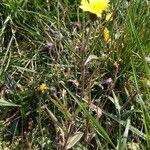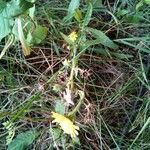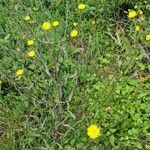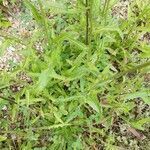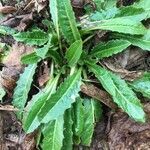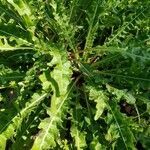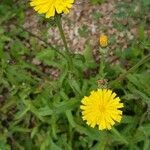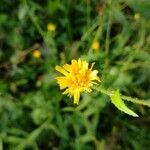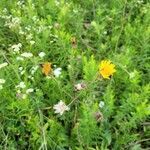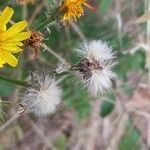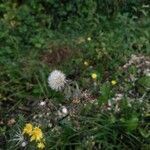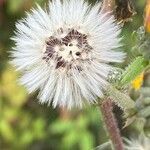Biennial herb up to 1 m. tall; stem branched in inflorescential region, arising from stout taproot, ribbed, densely clad in stout bristles c. 2 mm. long, ∞ axis; the bristles shorter, finer and less dense on branches. Basal lvs up to 10 × 2 cm.; oblanceolate, cuneately narrowed to subamplexicaul base. Stem-lvs lanceolate-oblong, sessile by broad subamplexicaul base, diminishing to linear bracts of infl. Capitula few to many; sub-corymbosely arranged, on long hispid pedicels; 1-1·5 cm. long, 1 cm. diam. Outer phyll. 4-6 mm. long, linear, ± hispid, often bearing cottony wool. Inner phyll. erect, subequal, c. 8-10 mm. long, indumentum similar. Achenes 2.5-3 mm. long, narrow-oblong, compressed, abruptly narrowed to very short beak. Pappus-hairs unequal, up to 6 mm. long, slender, sparsely plumose with long slender hairs.
A stout, erect, hispid biennial or perennial herb, up to 2 m tall, stems irregularly branched above into a spreading corymb. Radical and lower stem leaves oblanceolate, narrowed below into a petiole-like base, up to 20 x 2 cm, upper stem leaves lanceolate, broad-based and clasping, all leaves coarsely toothed. Heads less than 1 cm across, solitary at the tips of the branches. Involucral bracts all alike in form, the outer shorter than the inner, linear-lanceolate with a median line of stout bristles. Flowers bright yellow. Achenes c. 4 mm long, cylindric, tapering slightly at both ends, longitudinally furrowed, transversely wrinkled. Pappus of slender plumose bristles, soon caducous.
Biennial or short-lived perennial 2–10 dm, with the aspect of Hieracium, spreading-hispid to subglabrous; lowest lvs oblanceolate, 7–30 cm (petiole included) × 0.5–5 cm, often deciduous, the others lanceolate or oblong, sessile and often clasping, reduced; heads several in a corymbiform infl; invol 8–15 mm, its bracts imbricate, less than 3 mm wide; achenes evidently rugulose, 3.5–6 mm, narrowed above but only very shortly and stoutly if at all beaked; pappus readily deciduous as a unit; 2n=10. Waste places; native of Eurasia, occasionally found in our range. July–Sept.
A herb. It can grow for 2 or for several years. It grows 60-90 cm tall. The leaves are divided or have large teeth. They are bristly on the veins underneath. The leaves near the base are fattened sword shaped and 7-20 cm long. They narrow at the base to a short leaf stalk. The leaves higher up clasp the stem. The flower is bright yellow. Possibly now Picris angustifolia
